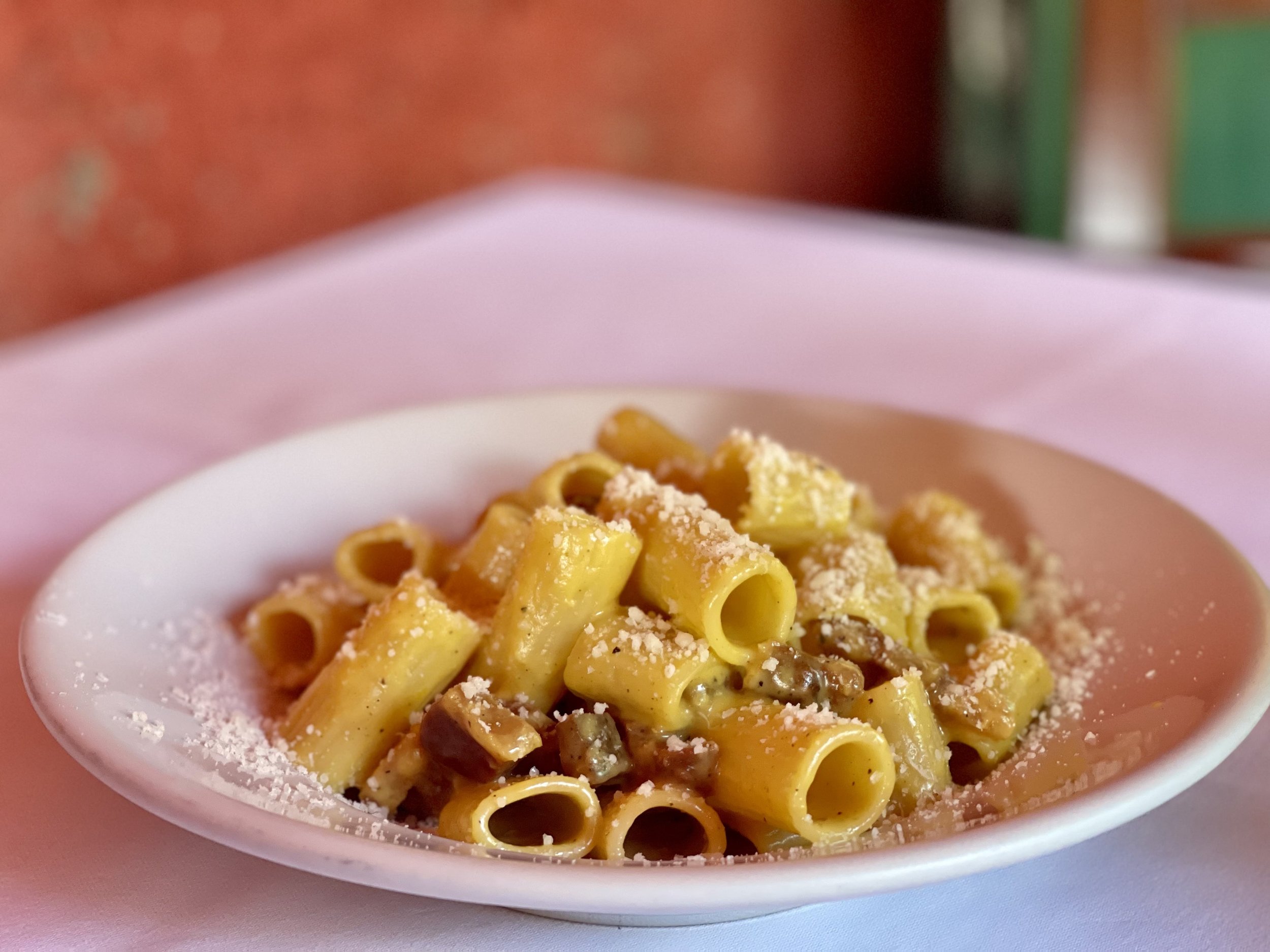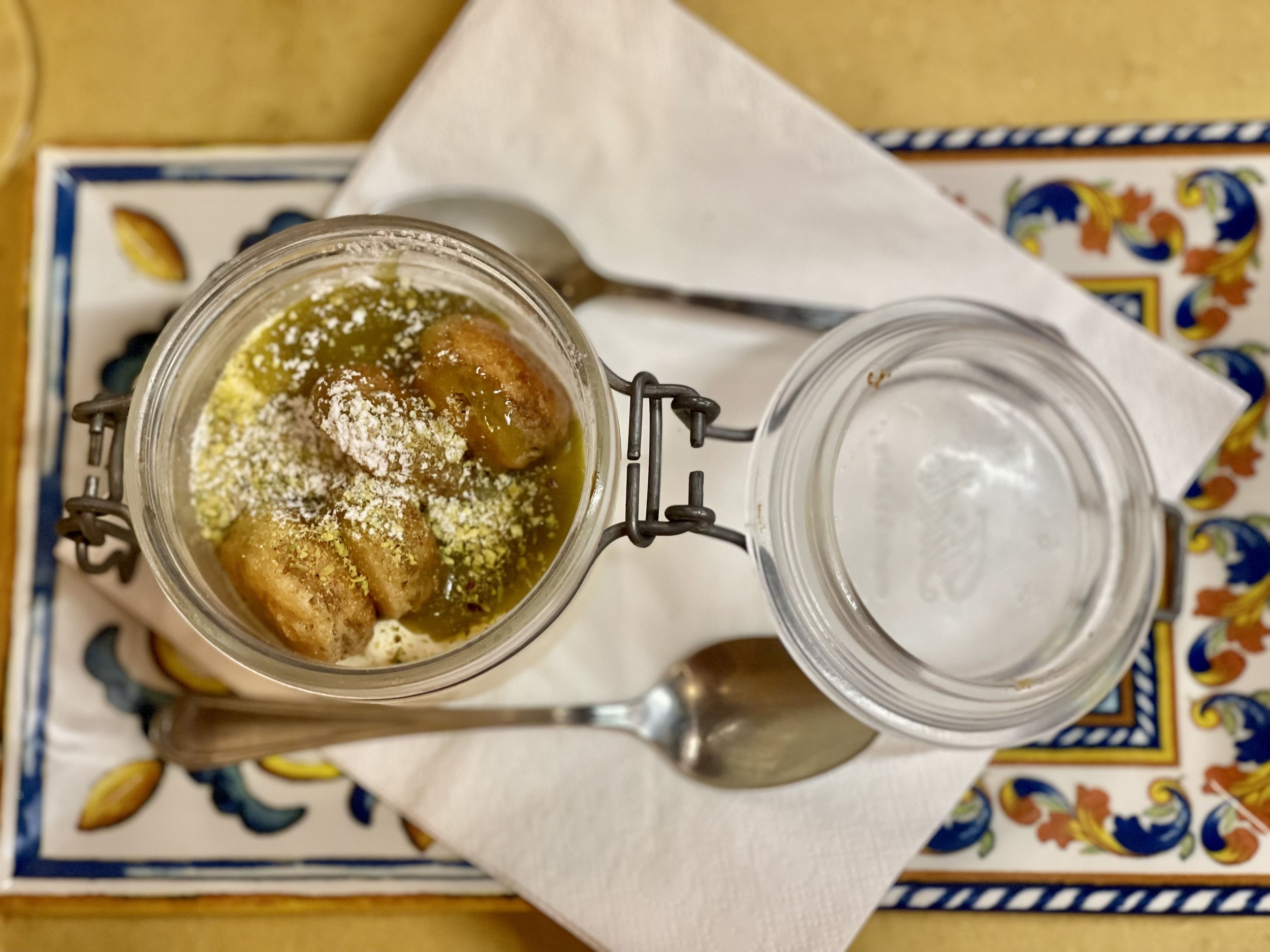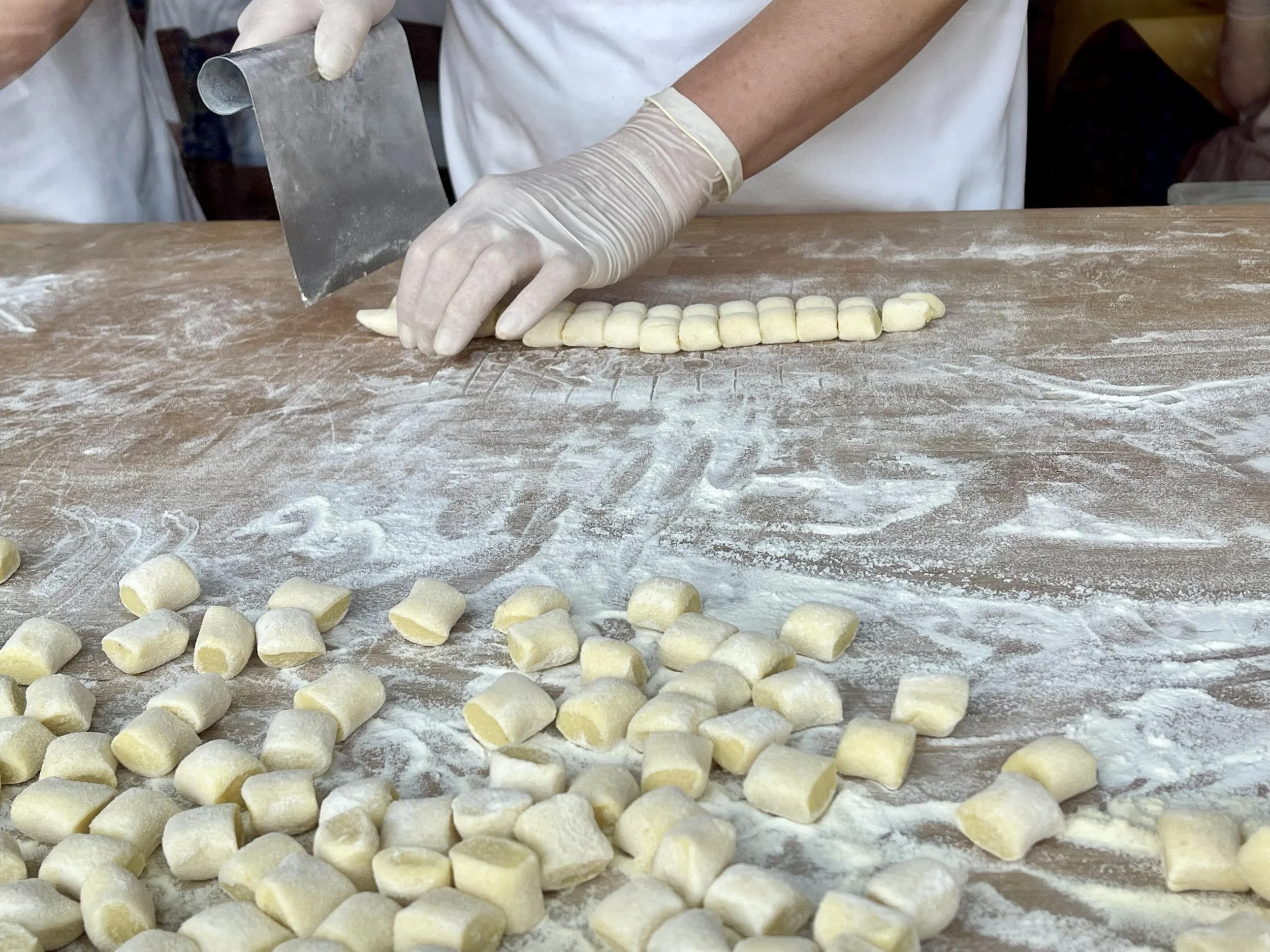Foodies in Rome: 13 Things Every Foodie Should Do
Are you looking for the best culinary experiences for foodies in Rome, Italy? The best places to eat in Rome? The traditional Roman foods you should not miss? The hidden gems full of locals?
If so, this Rome food guide is for you!
In addition to the best restaurants in Rome, Italy, you’ll find the best street food, pastas, main courses, desserts, Jewish Ghetto specialties, food markets, food tours, and more!
Foodies in Rome should try Amatriciana.
Yes, I’m a foodie. I’m also a chef who knows good food and am a long-time traveler to Rome. So, when I’m in the Eternal City, my visit revolves around culinary experiences.
In this guide, I’ve compiled all of my best of the bests here in one place so that every foodie in Rome can have as much fun as I do when visiting.
Let’s face it, Rome is quite a large city, and can definitely be overwhelming. Especially if you’re a foodie who doesn’t want to miss out. Allow me to help!
Foodies in Rome Should . . .
1. Eat the Four Types of Pizzas in Rome
When you think about authentic Italian food to eat in Rome, pizza has got to be on your list.
And yup, foodies in Rome will want to try four kinds of pizza—the first three originated in Rome.
Pizza al taglio
Pizza al taglio is a large rectangular street food pizza that is cut and served by the slice and sold by weight.
It can be toppingless with just olive oil and salt like Pizza Bianca. Or pizza chefs today often put a modern twist on it by combining all types of ingredients into colorful works of art.
A short walk from the Vatican museums, Bonci Pizzarium is the most famous pizza al taglio in Rome.
Pizza Romano
This round Roman-style pizza is served in pizzerias and sit-down restaurants, that is, it’s not on the street. It has a thin crispy crust, and it is customary for one person to eat a whole pie.
Some of the most popular Pizza Romanos are capricciosa (mushrooms, olives, ham, artichoke, tomato, and cheese), sausage and rapini, and pizza margherita (tomato, basil, and mozzarella).
Some of the best Pizza Romano can be found at Emma Pizzeria in the heart of Rome.
Pinsa Romana
The oval-shaped Pinsa Romana is crisp on the outside and soft on the inside. Toppings range from traditional to creative.
When you see Pinsa Romana, you may think, oh, flat bread. But the dough is made with a specific mix of soy, rice, and wheat flours, so it’s probably different than anything you’ve had before.
At Pinsitaly near the Trevi Fountain, you can try traditional savory pinsas, and then have a sweet one for dessert.
Pizza Napoletana
Since Italian cuisine is so regional, it may seem weird that Rome restaurants serve Pizza Napoletana. Not only is Neapolitan pizza the original pizza in Italy, but it’s even recognized by UNESCO.
The most famous food from Campania is characterized by a thick, fluffy, charred rim and a soft, thin pizza crust— this is the pizza dreams are made of.
This pizza style is all about the dough and crust, so toppings are usually kept simple. The Margherita is hands down the most famous Napoletana pizza.
Since Naples is only a little over an hour south of Rome, some Neapolitan master pizza chefs have opened pizzerias in the Italian capital. Among these, you can’t go wrong at Antica Pizzeria da Michele or, for those that love toppings, 50 Kalò di Ciro. Eating pizza is the one of the best things to do in Naples and now Rome too!
Read more about pizza in Rome: Best Pizza in Rome, Italy
2. Eat the Famous Roman Street Foods
Some of the best food Rome, Italy, has can be found on the streets!
In Rome, you are not going to find pods of food trucks like in Portland, Oregon. Instead, the street food in Rome will be found at the food markets, the bakeries, the salumerias, and various takeaway eateries.
In addition to the pizza al taglio mentioned above, supplì and porchetta are very popular Roman street foods you should not leave Rome without trying.
Supplì
Supplì are oval-shaped fried rice balls filled with tomato sauce and cheese. This beloved Roman street food is often served as an appetizer at pizzerias. However, the majority of Rome’s supplì are from street food vendors.
If you’re in Trastevere, Supplì Roma is the perfect place for a supplì snack.
Porchetta
Porchetta is made from seasoned roasted suckling pig. The meat is incredibly tender and makes amazing sandwiches. In fact, I think porchetta is one of the best things to eat in Rome—period.
Our number one pick for the best porchetta in Rome comes from my favorite Roman bakery, Antico Forno Roscioli in the city center. A close second is the salumeria La Vita è un Mozzico.
Read Next: Street Food Rome: Top 10 Eats on the Streets
3. Explore the Food of the Jewish Ghetto
Everyone should visit the Rome Jewish Ghetto—especially foodies. The main street of this historic quarter, Via del Portico d’Ottavia, bustles with eateries serving the traditional food of the ghetto. Here’s what not to miss.
Carciofi alla Giudia
The most famous food in Rome’s Jewish Quarter is Carciofi alla Giudia, or Jewish-style artichokes. These are whole fried artichokes where the leaves are crispy and the heart is soft.
Piperno
Piperno is our #1 choice for Jewish artichokes, and it’s one of the best places to eat in Rome for special occasions. But don’t be alarmed, that doesn’t mean pricy! Quite the contrary, from apps to pastas to traditional main courses, this charming restaurant is very affordable!
Fried Appetizers
There are many more delicious specialties besides artichokes to try at the Jewish Roman restaurants. All of the restaurant menus here are also likely to list fried anchovies, fried salt cod, mozzarella ’n carozza (Italian grilled cheese with anchovies), and fried zucchini blossoms as antipasti (starters).
Nonna BeTTA
The family-run restaurant Nonna Betta is a great spot at which to sit outside on Via del Portico d’Ottavia with a table full of traditional Jewish appetizers. BTW, this was Anthony Bourdain’s pick for where to eat Jewish-style artichokes in Rome.
Read more about the food of Rome’s Jewish Quarter: 10 Best Jewish Ghetto Rome Restaurants
4. Eat the Four Roman Pastas
The best carbonara in Rome is at Flavio Al Velavevodetto.
When it comes to finding the best pasta in Rome, you’ll want to stick to the traditional dishes: Cacio e Pepe, Carbonara, Gricia, and Amatriciana.
These four Roman pasta dishes will be prepared with one of the regional specialties: tonnarelli, bucatini, spaghetti, or rigatoni. And, of course, you should hold out for handmade fresh pasta.
The authentic Roman recipes for these dishes use only a handful of ingredients. At the core of all of them is black pepper and one of the most popular Italian cheeses: Pecorino Romano cheese.
Cacio e Pepe
Cacio e Pepe is the simplest of the Roman pastas. The name means “cheese and pepper,” and other than the pasta itself, the only ingredient in addition to those two is pasta water. Cacio e Pepe usually comes with tonnarelli or bucatini as the pasta type. If you can’t wait until you get to Rome to have some of this wonderful pasta, make our authentic foolproof recipe at home: Cacio e Pepe Recipe.
Pasta alla Gricia
Gricia is named after a small town in the Lazio region where this dish originated. The base is similar to Cacio e Pepe, with the addition of guanciale (pork cheek). It is most often served with rigatoni.
Carbonara
Carbonara basically takes Pasta alla Gricia and adds egg yolk to make it even more creamy. Spaghetti alla Carbonara is the go-to pasta type in Rome, but I’ve ordered quite a few Carbonaras with rigatoni as well.
Amatriciana
Amatriciana also uses Gricia as the base—it then adds tomatoes. Bucatini or spaghetti is the traditional pasta used for this dish, but many Roman restaurants will also use rigatoni.
See #6 below for the best restaurants in Rome for traditional dishes.
If you want to learn more about Italian restaurant types like osterias, trattorias, restaurants, etc., read Osteria vs Trattoria vs Ristorante vs Enoteca.
5. Eat the Traditional Dishes of Roman Cuisine
What food is Rome famous for? Besides the four pastas, Roman classics also include a variety of meat dishes.
You may have had Chicken Cacciatore at Italian restaurants in your hometown, and you’ll see it on menus in Rome—although it’s more likely that you’ll see Rabbit Cacciatore, known locally as Coniglio alla Cacciatora.
But there are soooo many more dishes of traditional Roman cuisine that you’ve probably never had—try one of those! Any restaurant in Rome, Italy, specializing in the food of Rome will have the following:
Coda alla Vaccinara
A very popular piatto Romano, Coda alla Vaccinara translates to “oxtail stew.” The meat simmers in a tomato base until tender and then falls off the bone.
La Pajata
Trying this dish is going to take a mixture of curiosity and courage, but La Pajata is the pride of authentic Roman trattorias. It is served as a main course and is made from the small intestines of unweaned calves.
Abbacchio alla Scottadito
“Abbacchio alla Scottadito” means “grilled lamb that burns your fingers.” So, go ahead and eat this dish with your hands as intended.
Saltimbocca alla Romana
Saltimbocca alla Romana is thinly sliced veal topped with prosciutto and sage in a butter white wine sauce.
Read Next: 24 Foods of Rome, Italy: Must-Try Roman Dishes
6. Eat at Traditional Restaurants
If you prefer fine dining, you can certainly eat at Michelin-starred restaurant in Rome—they have 22. But you can do that in any big city.
I urge foodies in Rome to dive into authentic Roman cuisine. For me, the best restaurants in Rome, Italy, have locals at their tables, feature recipes that have been passed down from generation to generation, and charge affordable prices.
All of the restaurants below meet my “best restaurants of Rome” criteria, and are among my favorite places for cucina Romana.
Armando al Pantheon
This is the first reservation I make when I’m headed to Rome! The Cacio e Pepe and Abbacchio alla Scottadito are top-notch!
As the name suggests, Armando al Pantheon is just steps away from one of the biggest tourist attractions in Rome, the Pantheon. Yet, this restaurant remains a local institution committed to serving top-quality Roman fare at reasonable prices.
Flavio Al Velavevodetto
Located on the slopes of Monte Testaccio, Flavio Al Velavevodetto is known for the creamiest Carbonara in Rome. And it’s not just hype—I definitely think it’s the best restaurant in Rome for Carbonara.
I have sampled so many Carbonara dishes throughout Rome, and this is my favorite. In addition, everything else I’ve ever had on their traditional menu is outstanding.
Trattoria da Cesare al Casaletto
A little off the beaten path, Trattoria da Cesare al Casaletto is one of the best restaurants in Rome if you’re looking for a locals only kind of vibe. I love it!
Their Pasta alla Gricia is supreme, and their Involtini di Manzo al Sugo (Beef Rolls with Sauce) melt in your mouth.
Looking for more of the best affordable restaurants in Rome? Read 29 Best Cheap Eats for Frugal Foodies.
7. Visit the Rome Food Markets
Rome boasts over 100 food markets of varying sizes throughout its many neighborhoods. They are a great place to peruse the local produce and taste the local specialties.
Each market is different, so foodies visiting Rome will want to visit more than one!
Mercato di Testaccio
The Testaccio Market is my favorite for lunch because of Mordi e Vai. If you can only eat one thing in this market, make it their Allesso di Bollito Panino. I like to top this tender beef sandwich with sautéed greens and salsa verde.
There’s lots more to munch on too! Check out a couple of other faves. For salumi, porchetta, and Italian cheeses, try La Prosciutteria di Enzo e Lina (Box 89), and for pizza al taglio, head to Casa Manco at Box 22.
Mercato Trianfale
Both the largest and the oldest covered food market in Rome, the Trianfale Market in the Pratti neighborhood near Vatican City is worth a visit.
With 270 stalls, vendors sell everything from fresh eggs, baked goods, and cured meats to clothing and household items.
Campo de’ Fiori
I must admit, Campo de’ Fiore is not my favorite market, but it is one of the most beautiful. Moreover, it is the most famous and the oldest open-air food market in Rome. So, you really should check it out.
There are still some fresh flower and produce stands, but nowadays this market abounds with bottles of olive oil and other foodie souvenirs. Go for a walk through rather than to eat.
Read Next: Best Food Markets in Rome
8. Save Room for Dessert
To truly experience La Dolce Vita (the sweet life) when you travel to Rome, you must indulge in dessert!
Every restaurant in Rome will offer at least a few sweet treats to tantalize your taste buds. If you didn’t save room, take a walk. Then, when the urge hits, there will always be a haven for dessert close by.
Gelato
There are so many places to get extraordinary gelato in Rome! On the other hand, there are a lot of gelato shops just for tourists—where they whip the gelato full of air and the offerings on display look way better than they taste.
You won’t be disappointed at Giolitti near the Pantheon, Frigidarium near the Piazza Navona, or FataMorgana at any of its 8 shops in Rome.
Tiramisu
Even though it hails from the north of Italy, Tiramisu is by far the most popular dessert on Rome restaurant menus. There are also numerous Tiramisu shops offering a variety of flavors in addition to the espresso, mascarpone, and chocolate original. I am a big fan of Pistachio Tiramisu.
Tiramisu lovers should stop at Pompi, dubbed “The King of Tiramisu.” It’s a 2-minute walk from the Spanish Steps.
To discover more traditional Roman desserts, read 20 Best Desserts in Rome.
9. Eat Dessert for Breakfast
Sure, pastries can be decadent desserts, but they’re also part of a typical Italian breakfast.
Some restaurants have started to cater to American and English tourists by offering eggs and savory dishes on cafe menus (like at Roscioli Caffè Pasticceria). But you should have at least one Italian breakfast that consists of just coffee and pastries. OK, add a juice too if it makes you feel you’re ordering something healthier.
Maritozzo
This quintessential Roman pastry consists of a sweet brioche bun stuffed with loads of fresh whipped cream. Simple, but oh so divine.
Almost every bakery in Rome will have a version of Maritozzo. The best ones are sold at a little hidden gem on the edge of Trastevere called Il Maritozzaro.
Crostatta alle Visciole
I usually prefer savory breakfasts to sweet. But on my last trip to Rome, my first meal of the day often included a slice of this sour cherry tart. Sometimes I also added a cornetto (Italian croissant) or a slice of ciambellone (similar to sponge cake).
A perfect place for Crostata alle Visciole, cream puffs, fruit tarts, and even Maritozzo (my 2nd favorite spot in the city) is the historic Regoli Pasticceria.
To find out more about Rome’s best breakfast pastries, read Best Italian Breakfast Pastries.
10. Experience Italian Coffee Culture
Is the coffee in Rome really so different from that at your hometown coffee shop? It sure is!
First off, there’s a whole different lingo. If you order a coffee, you’ll receive a small cup filled with a shot of espresso.
Secondly, some of the best coffee in Rome is often served at bars where you stand up to drink it. When bars open in the morning, they serve coffee; later in the day they transition to alcohol.
If you want to linger over a cappuccino, going to a caffè will be your best bet. But beware, Italians have a strict coffee culture and nobody drinks cappuccino after noon.
Antico Caffè Greco
The perfect spot to enjoy an authentic Roman coffee experience is Antico Caffè Greco, the oldest cafe in Rome.
Want to know more about the coffee culture in Rome, read 15 Best Cafes in Rome.
11. Go to a Wine Bar
Most wine bars in Rome give free snacks with your order.
Of course, coffee isn’t the only drink in town. Italy is the second largest wine producer in the world after France.
One of the best ways to learn about the wine of the Lazio region—of which Rome is a part—is to go to a local wine bar or enoteca.
At enotecas, you can hang out with a glass of wine, or a bottle, and some will also offer flights. Some wine bars will also serve up food to accompany your wine.
Menu items can range from simple Italian salumi boards to gourmet fare.
Trimani il Wine Bar
A short walk from the Piazza della Repubblica and Rome Termini Station, Trimani offers an indoor counter for tastings and an outdoor patio where you can also order appetizers or pastas. The helpful staff will also be happy to answer any questions.
Giulio Passami L’Olio
We stumbled upon this hidden gem walking around after dinner one night. It was so charming and the only language we heard spoken was Italian.
We returned the following evening, and indeed, it was not just full of locals, but the owner had a large table full of friends. It felt like the whole neighborhood was there. Pro Tip: If you’re a truffle-loving foodie, their Cacio e Pepe with truffles is the best truffle deal in town!
12. Take a Rome Food Tour
Especially if you’re strapped for time, a Rome food tour can provide a wealth of information and tasty tidbits in just a few hours.
Rome food tours are a fantastic way to learn about the local food and history at the same time.
Your tour is basically one big tasting menu as you progress from one stop to another.
Small-Group Rome Food Walking Tour
For a great overview of three different neighborhoods—Trastevere, Campo de’ Fiori, and the Jewish Ghetto, your best bet is this award-winning tour: Small-Group Rome Food Walking Tour.
You’ll taste Roman pasta dishes, pizza, cheeses, supplì, salumi, and more!
Learn about more food tour options here: Best Rome Food Tours
13. Take a Rome Cooking Class
Rome is one of the best Italian cities in which to take a cooking class. A chef will teach you about local ingredients and how to create some of the most delicious traditional Roman food.
Afterwards, you will be rewarded with a meal that rivals some of Rome’s best restaurants.




















